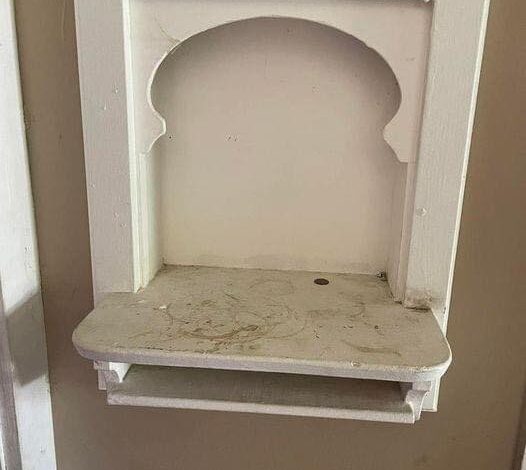What was this for and why a bottom shelf

If you live in a house built between the early and mid-1900s, you may have noticed a small, built-in shelf nestled into a wall, often in the kitchen or hallway. This quaint feature, known as a “phone alcove,” might seem unusual today, but it was once an essential part of many homes.
The Purpose of the Phone Alcove
Before the rise of smartphones, homes were often designed around a central landline telephone, which was typically the only phone in the household. These landlines were vital for communication, and phone alcoves provided a convenient spot to store the phone. Typically placed in high-traffic areas like kitchens or hallways, these alcoves made the phone easy to reach for everyone in the home.
The alcove usually featured a shelf at the right height to hold the phone, with a small drawer or compartment below it to store items like an address book, phone directory, or notepad. In a time when phone numbers and addresses were handwritten, having a dedicated space for these essentials was just as important as keeping our smartphones close today.
Why Were Phone Alcoves Positioned So Low?
You might wonder why these alcoves were often placed lower on the wall. This was due to the design of early landline phones, which had heavy receivers and short cords. The lower placement allowed users to sit or stand comfortably while using the phone, and made it accessible to everyone, including children. It also helped prevent the receiver from being dropped and damaged.
At that time, it was common to settle in one spot for a conversation, a far cry from today’s world where phones are portable and cordless.
Modern Uses for a Phone Alcove
Although phone alcoves are no longer used for their original purpose, there are many ways to repurpose these charming features in today’s homes. Here are some ideas:
- Decorative Touch: Place a vintage phone or cherished family heirlooms in the alcove as a tribute to the past. This can be a nostalgic and unique addition to your home décor.
- Storage Nook: For those who appreciate practicality, use the alcove to store everyday items like keys, mail, or notepads. It could also serve as a small bookshelf for cookbooks or novels.
- Plant Display: If you enjoy plants, the phone alcove is a perfect place for small potted plants, such as succulents, ferns, or air plants, bringing a fresh, natural element into your home.
- Charging Station: With a little creativity, you can turn the alcove into a tech-friendly charging station. Add an extension cord or power strip to keep your devices organized and easily accessible.
The Appeal of Old Home Features
Older homes often contain distinctive design elements that modern homes lack. While new constructions focus on open spaces and minimalist designs, older homes have quirky features like phone alcoves, built-in ironing boards, and milk doors that add character. These details offer a glimpse into the past and make each home feel special.
Even though newer homes emphasize sleek, modern designs, older homes stand out with their unique, historical charm. Many homeowners appreciate these vintage touches that give their homes personality and a sense of history.
My Affinity for Vintage Home Details
Although I live in a contemporary home, I’ve always been captivated by the character of older houses. Imagining families gathered around a fixed phone in the hallway or using an address book to record numbers feels heartwarming. I may not have a phone alcove in my own home, but I can certainly appreciate the nostalgia and charm these details bring to a space.
Embracing the Past in Today’s Homes
While the original purpose of the phone alcove may no longer be relevant, it serves as a reminder of how home design has evolved over time. Even though landlines are nearly obsolete today, the alcove’s potential for modern use ensures it still has a place in many homes. Whether you transform it into a storage space, a plant display, or simply leave it as a tribute to the past, the phone alcove is a lovely remnant of simpler times. If you’re lucky enough to have one, embrace it—who knows what new purpose you might find for it in your home’s unique style.